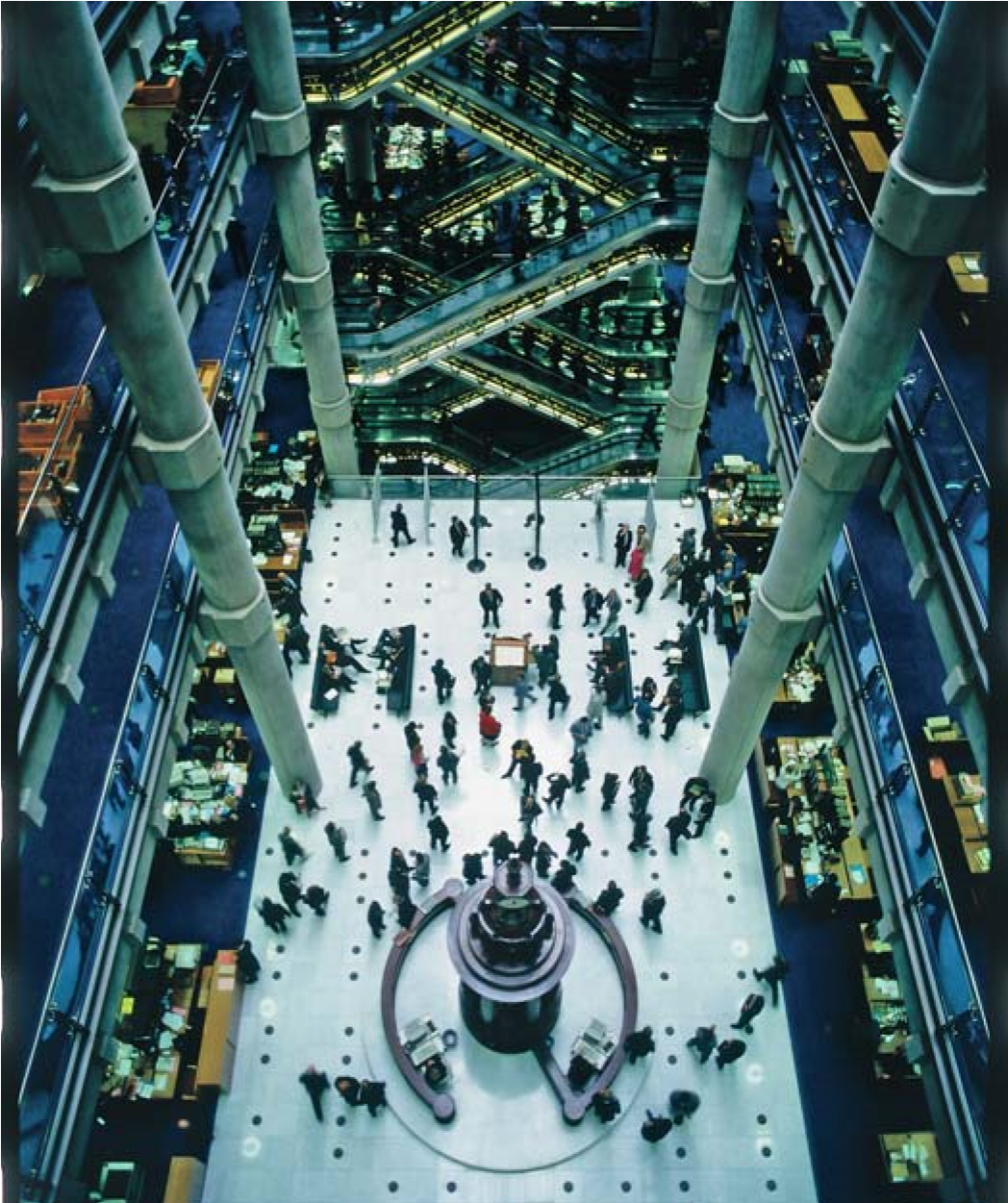RSHP projects on the CTBUH most influential tall building list

|
Contents |
[edit] Introduction
The Leadenhall Building and Lloyds of London have been selected as two of the 50 most influential tall buildings of the last 50 years.
In its 50th anniversary, The Council on Tall Buildings and Urban Habitat (CTBUH) has named both buildings in the 50 Most Influential Tall Buildings of the Last 50 Years. The full list will be revealed in the lead up to “50 Forward | 50 Back”, CTBUH’s 10th World Congress in Chicago at the end of October 2019.
CTBUH is the world’s leading resource for professionals focused on the inception, design, construction and operation of tall buildings and future cities. The list of 50 buildings has been compiled through an open call to the CTBUH member constituency at large, with input from on-staff tall building experts.
The Leadenhall Building and Lloyd’s of London demonstrate significant developments in tall building construction and chart the evolution of the practice.
[edit] Leadenhall Building
The 50-storey Leadenhall building is a modern landmark in slender form creating a tapering profile on the London skyline, respecting views towards St Paul’s Cathedral. CTBUH highlights the building’s innovative structural design as a strong influential architectural feature. They state “the design strategy of the Leadenhall Building centres around its lobby’s elevation above the ground plane, creating a generous public plaza, and its offset steel ‘megaframe’ core, affording column-free floor plates of varying depths. It is the world’s tallest building to have used this strategy.”
Graham Stirk, RSHP Senior Design Partner said: “We are delighted that both Lloyd’s of London and the Leadenhall Building have been recognised in CTBUH’s 50 most influential buildings in the last 50 years, particularly as it places them alongside some of the finest towers that have also influenced us over this period. The influence and language of the Lloyd’s of London building can be traced within the design and manufacture of The Leadenhall Building, which reflects the construction technology of its time. It is a powerful distillation of the key components that make a successful tall office building and its placing within a particular London context, resulting in its distinctive profile and a cathedral-like public space at the base. The profile is further emphasised by a clearly legible structure which – when combined with the dynamic and visible service cores and vertical movement within the single north core – creates what we believe to be a building of immense, if not heroic, clarity.”
While charting recent RSHP design, the Leadenhall Building also has a more intimate connection with the practice: it provides a home for its head office on floor 14 from where staff can look across Leadenhall Street to the practice’s earlier work, the second RSHP building on the 50 most influential tall buildings list: Lloyds of London.
[edit] Lloyds of London
Lloyds of London was completed during the early days of the Richard Rogers Partnership (RRP). It is regarded as one of the great architectural achievements of the 1980s and is one of the buildings that confirmed the practice’s position in the front rank of international architects. The building was Grade I-listed in 2011, the youngest structure to obtain this status.
In selecting Lloyds of London for the list, CTBUH said: “The Lloyds Building is distinguished by its ‘inside-out’ transposition of internal services to the exterior, leaving an uncluttered space inside. Modular in plan, each floor can be altered by addition or removal of partitions and walls.”
As Richard Rogers said about the building: “Lloyds wanted a building that would last into the next century – we met that one – and they wanted a building that could meet their changing needs. The real critical thing in architecture is having a good client. A good client is not somebody who just says 'yes', it’s a client that is engaged in the evolution of the building, who responds.”
View the first 25 of the 50 Most Influential Tall Buildings of the Last 50 Years HERE.
[edit] About Rogers Stirk Harbour + Partners
Rogers Stirk Harbour + Partners is an international architectural practice based in London. Over the past four decades, RSHP has attracted critical acclaim and awards with built projects across Europe, the Americas, Asia and Australia.
The practice is experienced in designing a wide range of building types including: office, residential, transport, education, culture, leisure, retail, civic and healthcare. The quality of its designs has been recognised with some of architecture’s highest awards, including two RIBA Stirling Prizes, one in 2006 for Terminal 4 Madrid Barajas Airport and the other in 2009 for Maggie’s West London Centre.
The firm was founded as the Richard Rogers Partnership in 1977 but over time evolved and in 2007 the decision was made to rename the firm Rogers Stirk Harbour + Partners to reflect the vital contributions of Graham Stirk, designer of the award-winning Leadenhall Building, and Ivan Harbour, designer of the Stirling prize-winning West London Maggie’s Centre. The practice now has 13 partners, with several long-standing members of the practice being named partners in 2015. Together, they represent the inherent continuity and consistency of the philosophy which the practice applies to all its work.
[edit] About this article
This article was written by Vicki Macgregor, Strategic Communications & Marketing Manager at Rogers Stirk Harbour + Partners (RSHP). It previously appeared on the RSHP website in October 2019 and can be accessed HERE.
[edit] Related articles on Designing Buildings Wiki
More articles on RSHP projects can be found HERE.
--RSHP
Featured articles and news
Latest Build UK Building Safety Regime explainer published
Key elements in one short, now updated document.
UKGBC launch the UK Climate Resilience Roadmap
First guidance of its kind on direct climate impacts for the built environment and how it can adapt.
CLC Health, Safety and Wellbeing Strategy 2025
Launched by the Minister for Industry to look at fatalities on site, improving mental health and other issues.
One of the most impressive Victorian architects. Book review.
Common Assessment Standard now with building safety
New CAS update now includes mandatory building safety questions.
RTPI leader to become new CIOB Chief Executive Officer
Dr Victoria Hills MRTPI, FICE to take over after Caroline Gumble’s departure.
Social and affordable housing, a long term plan for delivery
The “Delivering a Decade of Renewal for Social and Affordable Housing” strategy sets out future path.
A change to adoptive architecture
Effects of global weather warming on architectural detailing, material choice and human interaction.
The proposed publicly owned and backed subsidiary of Homes England, to facilitate new homes.
How big is the problem and what can we do to mitigate the effects?
Overheating guidance and tools for building designers
A number of cool guides to help with the heat.
The UK's Modern Industrial Strategy: A 10 year plan
Previous consultation criticism, current key elements and general support with some persisting reservations.
Building Safety Regulator reforms
New roles, new staff and a new fast track service pave the way for a single construction regulator.
Architectural Technologist CPDs and Communications
CIAT CPD… and how you can do it!
Cooling centres and cool spaces
Managing extreme heat in cities by directing the public to places for heat stress relief and water sources.
Winter gardens: A brief history and warm variations
Extending the season with glass in different forms and terms.
Restoring Great Yarmouth's Winter Gardens
Transforming one of the least sustainable constructions imaginable.























